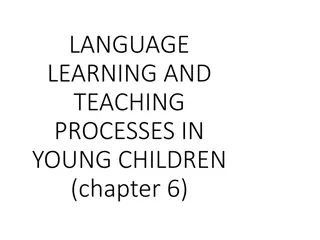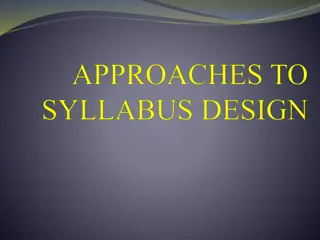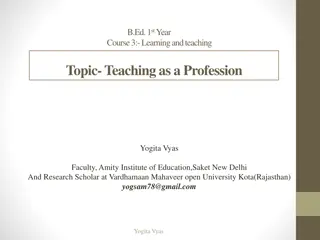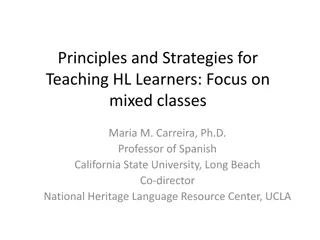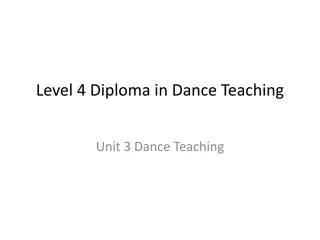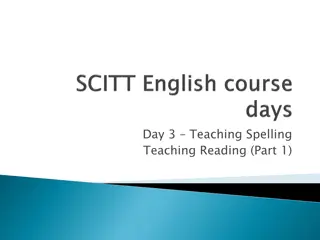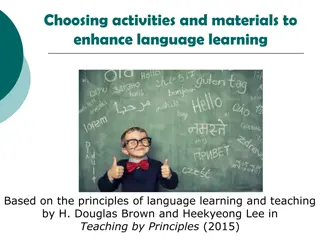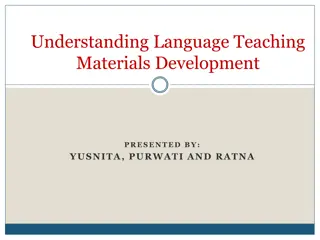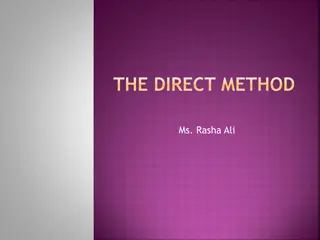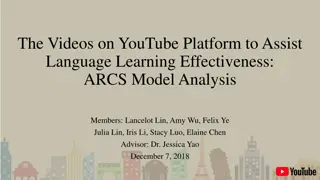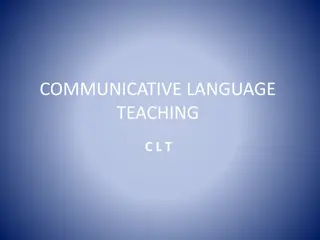Exploring the Use and Impact of Coursebooks in Language Teaching
Teachers worldwide still heavily rely on coursebooks despite the prevalence of digital technology in language learning. This research delves into motivations behind using coursebooks, their benefits, and examines their efficacy in facilitating language acquisition. Different ways teachers utilize coursebooks are also discussed, highlighting the complexities and nuances of their integration in the classroom.
Download Presentation

Please find below an Image/Link to download the presentation.
The content on the website is provided AS IS for your information and personal use only. It may not be sold, licensed, or shared on other websites without obtaining consent from the author. Download presentation by click this link. If you encounter any issues during the download, it is possible that the publisher has removed the file from their server.
E N D
Presentation Transcript
Using Coursebooks: Do We? Why Do We? How Do We? And How Could We? Brian Tomlinson brianjohntomlinson@gmail.com
Heinemann ELT is carrying out major research into the way coursebooks are used and received in ELT adult and young adult classrooms around the world.
We are looking for classroom teachers and directors of studies who would welcome the opportunity to help us with our research which will investigate teaching contexts and the relationship between the coursebook, the teacher and the learners. Heinemann ELT (1993).Folio. 2/1, 24.
Do We Use Coursebooks? A glance at any language teaching journal in the last ten years gives the impression that in most language classes these days learners are using computers, tablets and mobile phones rather than coursebooks. The reality though is that the vast majority of language classes around the world are still being taught. And they are being taught by teachers using coursebooks. (See for example, British Council (2008); Tomlinson (2010), Saw, (2016))
Why Do We Use Coursebooks? According to my experience and research (e.g. Tomlinson, 2010) it s because: 1. of compulsion; 2. of (excessive)reverence; 3. of face validity; 4. it saves the teacher time (see, if you can, Tomlinson, XXXX); 5. it gives confidence to inexperienced teachers; 6. it provides texts for the teacher to make use of (see Tomlinson, XXXY; 7. it makes teaching easier (especially as these days most coursebooks are clones of each other); 8. It makes teacher training easier; 9. it helps administrators to timetable and standardise; 10. it s the norm.
But does using a coursebook help the learners? It does provide security and system, it does satisfy expectations and it does provide a source of reinforcement and revision. But does it typically facilitate language acquisition for the learners? Hadley ( 2014)says it does. But then his pre- and post-tests were mainly discrete item coursebook placement tests. (See Tomlinson & Masuhara (2018, pp. 25-28) for a discussion of the value or otherwise of coursebooks).
How Do We Use Coursebooks? My observation, reading and research tells me that teachers do one or more of the following: 1. follow their coursebook as a script; 2. augment their coursebook; 3. adapt their coursebook to increase its potential effectiveness; 4. use their coursebook as a resource (e.g. as a stimulus for interaction; as a trigger for in-house teacher development); 5. satirise their coursebook; 6. make token use of their coursebook; 7. use the coursebook as an incentive to do something else (e.g. Meddings & Thornbury (2009); Tomlinson & Masuhara (2018, pp. 28-29).
For research studies on how we use coursebooks see Harwood (2014), McGrath (2013), Tomlinson and Masuhara (2018, pp. 29- 31; pp. 82-116).
How Could We? My question has three meanings: 1. How could we have written so many unengaging coursebooks? 2. How could we have used so many unengaging coursebooks? 3. How could we use coursebooks in more engaging and effective ways?
1. How could we have written so many unengaging coursebooks? We ve done so because of: misunderstanding what facilitates language acquisition; the need to achieve face validity; the demands of synthetic syllabuses and knowledge testing examinations; the need for teachers to set and mark classroom tests; the cloning of best-selling coursebooks; publisher censorship of topic content.
2. How could we have used so many unengaging coursebooks? We ve done so because of: excessive reverence; lack of choice; fear of innovation; CONVENIENCE.
3. How could we use coursebooks in more engaging and effective ways? 1 We could add a lead-in text (i.e. a potentially engaging text which readies the learners minds for the core text in the coursebook) For example, I d tell the following personal story about a computer help shop before the students turn to 5.1 The advantages and disadvantages of modern technology in Speak Out Intermediate (Clare & Wilson, 2012).
2 We could supplement (or replace) conspicuously inauthentic texts with potentially engaging authentic texts connected to the topic. For a wide range of discourse features (including lexicogrammatical items, speech acts, generic structure, and interactional features of contingent talk), ELT textbooks often provide learners with distorted or partial representations of the target language to work from, and these are likely to impact negatively on students developing communicative competence. This is the conclusion of Gilmore (2015) who refers to forty four sources of information about such distorted input.
3 We could make small changes which open up closed activities (Tomlinson, 2017) and thus stimulate valuable peer to peer interaction (Sato & Ballinger, 2016). For example we could turn A on p. 125 of Pre- Intermediate Outcomes (Dellar & Walkley, 2010) into a creative activity.
A Complete the sentences by adding because or so. 1 That part of the city is new you don t see any old buildings there. 2 People don t go out between 12 and 3 it s very hot. 3 The city was really polluted I moved to the country. 4 Lots of tourists visit the museum .. it s home to a lot of wonderful art. Teacher In your group use your four sentences to help you to write a short story called Sunset at Midnight.
4 We could make small changes which personalise activities. For example we could turn the grammar exercises on p. 55 of global intermediate (Clandfield &Robb Benne, 2011) into a personalised creative activity.
The grammar section gives examples of modals of permission and necessity in relation to robots and then gives the following instruction: 1 Read sentences 1-8. Match the words in bold with a meaning a-d. 1 A robot may create another robot. 2 A robot has to know that it is a robot. I d tell a joke about robots, do the exercise above and then add the following activity:
1 Write the beginning of a short story in which you ve bought a robot and taken it home. In the extract from your story show the robot your home and talk to it about its duties. 2 Swop stories with other students in the class. 3 If you are interested in robots and in stories read Ian Mc Ewan s new novel Machines Like Me.
5 We could make small changes which add the potential for affective and cognitive engagement. For example, we could add imaginative activities to the section on time travel on page 109 of Speakout Intermediate (Clare & Wilson, 2012). There is an expository text on time travel which the learners have to answer three surface questions on and then they the text to underline eight phrases with come, give, have and make,
I would add: Think about a time in the past or the future which you would like to go to. Think about a place and an event at that time. Imagine you are now in that place and time observing the event taking place. See pictures in your mind of what is happening. Suddenly there s a problem. See yourself being involved in the problem.
In groups of three tell each other what happened during your time travel. Then as a group choose one of your accounts and write it as a story. Exchange your story with another group and then add an ending to their story in which the problem is solved.
6 We could perform the coursebook in order to bring the coursebook to life. The coursebook can be performed by: the teacher; the students; interaction between the teacher and the students.
Heres an example of a teacher and student performance of the text on p. 45 of global intermediate (Clandfield & Benne, 2012). The Wall T. Could you just remind me of your names. I m going to act for you the beginning of a story. There are two characters in the story, A and B. I m playing both characters. As you ll see they both look alike and sound alike. That s because they re twin brothers and I m hopeless at accents. As you watch and listen try to imagine where they are and what they are doing.
You know something funny. Ive forgotten which side is which. You ve what? I ve forgotten which side we re supposed to be guarding from the other. You idiot. Some soldier you are. Which is it then? To our right we have our glorious homeland and to our left the barbaric wastes. Now? T. What s the problem? What do you mean Now ? Home is always on my right hand side. I ve memorized it. It can t always be on your right because if you turned around then your right would be where your left is. Oh. T. In pairs solve the problem. Then act out the scene with a solution added.
Then the students read the text and answer post-reading questions. Not the closed questions from the coursebook (e.g. What are the men s jobs? Find a positive adjective. But open-ended think questions such as What does the wall remind you of? and What do you think of the idea of building a wall between two countries?
For more examples of how small changes can add engagement and effect to coursebooks see: Faneslow (2018), Timmis (2016), Tomlinson (2017).
If small changes can make a coursebook more engaging and effective what are the implications for: coursebook development? teacher development? One implication is the need for hands on workshops in which writers and teachers gain experience in making small changes. A MATSDA Workshop?
And what about the learners? What do learners do with coursebooks? This is something we really need to find out. A topic for a future MATSDA Conference?
Conclusion 1 Let me conclude with an example of a very small change to 1a on page 36 of The Big Picture Intermediate (Goldstein, 2012). Choose the correct option to complete the sentences. 1 It s amazing/amazed how many things today can be called art . I think a lot of it is rubbish. Choose the correct option to complete the sentences. Then add a response to the sentence so it becomes the beginning of a conversation.
2 And finally a couple of quotations. i) We cannot solve our problems with the same thinking we used when we created them. Albert Einstein ii) If at first you don t succeed Try, try, and try again. BUT DO IT DIFFERENTLY. Tomlinson (15/6/2019)
References British Council. (2008). Teaching English: Course Books. London: http://www.teachingenglish.org.uk/talk/polls/course books Faneslow, J. F. (2018) Small changes in teaching big results in learning: Videos, activities and essays to stimulate fresh thinking about language learning and teaching. iTDi TESOL Online. Gilmore, A. (2015). Research into practice: The influence of discourse studies on language description and task design in published ELT materials. Language Teaching: Surveys and Studies, 48(4), 506-530. Hadley, G. (2014). Global textbooks in local contexts: an empirical investigation of effectiveness. In N. Harwood (Ed.), English language teaching textbooks: Content, consumption, production (pp. 205-240). Basingstoke: Palgrave Macmillan. Harwood, N. (Ed.). (2014). English language teaching textbooks; content, consumption, production. Basingstoke: Palgrave Macmillan. McGrath, I. (2013). Teaching materials and the roles of EFL/ESL teachers. London: Bloomsbury. Meddings, L., & Thornbury, S. (2009). Teaching unplugged: Dogme in English language teaching. Peasdale: Delta. Sato, M. & Ballinger, S. (Eds.). (2016a). Peer interaction and second language learning: Pedagogical potential and research agenda. Amsterdam: John Benjamins.
Saw, T. S. (2016). Evaluating the external materials used for cultural elements in ELT course-books through teacher perception of teaching and learning. Unpublished PhD thesis. University of Essex. Timmis, I. (2016). Humanising coursebook dialogues. Innovation in Language Learning and Teaching. 10/2, 144-153. Tomlinson, B. (2010). What do teachers think about EFL coursebooks? Modern English Teacher 19 (4), 5 9. Tomlinson, B. (2015). Challenging teachers to use their coursebook creatively. In A. Maley, & N. Peachey (Eds.), Creativity in the language classroom (pp. 24-28). London: The British Council. Tomlinson, B. (2017). Making typical coursebook activities more beneficial for the learner. In D. Bao (Ed.), Creative concerns in ELT materials development: Looking beyond the current design. Bristol: Multilingual Matters. Tomlinson, B. & Masuhara, H. (2018). The complete guide to the theory and practice of materials development for language learning. Holboken, NJ: Wiley. Tomlinson, B. & Masuhara, H. (forthcoming). SLA applied: The application of second language acquisition research of the learning of languages. Cambridge: Cambridge University Press.






